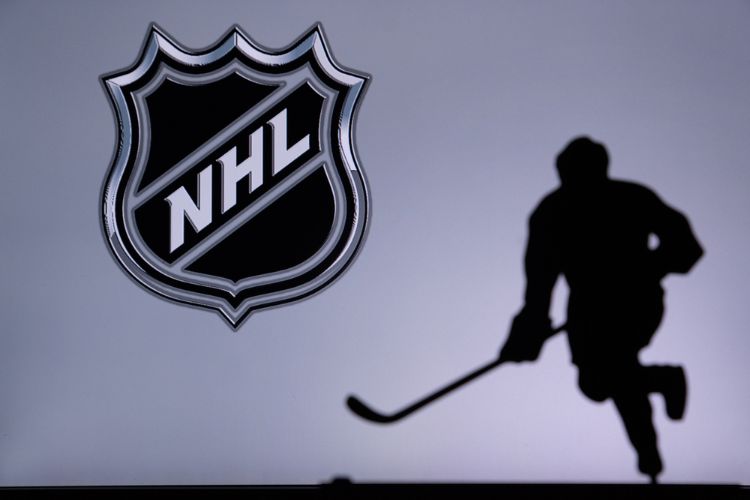The National Hockey League (NHL) is a North American professional ice hockey league, which is considered the top-ranked professional ice hockey league in the world. The league consists of 32 teams (25 from the United States and 7 from Canada).

After the 1909 National Hockey Association (NHA) folded, the NHL was founded in Montreal in 1917. It took the NHA’s place as one of several leagues that contested for the already existing Stanley Cup. However, after several years of mergers and disbandments, the NHL was the only league left competing for the cup in 1926.
When the league was first created, it consisted of four Canadian teams. It expanded in 1924 to include the United States team, the Boston Bruins. From 1942 to 1967, the league consisted of six teams, still referred to as “the Original Six”, but has expanded over the years to now include 32 teams (as of 2021).
Teams in the NHL play to win the Stanley Cup (the oldest professional sports trophy in North America), awarded to the playoff champion each season. The NHL is one of the four major professional sports leagues in the United States and Canada and is the fifth-wealthiest (by revenue) professional sports league in the world.
Famous National Hockey League Trademarks
The National Hockey League has been a leading ice hockey league since 1917 and is one of the wealthiest leagues in the world. It stands to reason that they would have a multitude of trademarks to their name to protect their assets and IP. They currently have 97 trademarks registered with USPTO. Let’s take a look at some of the NHL’s most famous trademarks, registered by the National Hockey League.
NHL logo
The first thing the NHL trademarked was its logo, which has remained largely unchanged since it was first used in 1917. The original logo features a black shield with “NHL” written in yellow on a diagonal framed between two yellow lines above and below it.
The logo was redesigned in 1946 slightly. The shield became a little shorter and wider, with the white outline removed. The color of the words was also made darker, looking more orange and the text, lines, and outlines were made bolder.
The latest logo has been used since 2005 and has the most notable changes. It now features silver and grey writing, lines, and outlines rather than orange. The lines also feature shading to appear 3D and glossy. They also changed the direction of the “NHL” to now start from the bottom left corner to the upper right corner.
The first logo they trademarked was filed in 1968, and none of the logos trademarked featured orange coloring. Meaning that all trademarked NHL logos actually look more similar to the latest one. The trademark for this NHL logo was registered in 1970 and applies to:
- Indicating membership in an applicant
- Association services-namely, promoting the interests of league members’ ice hockey teams and the game of ice hockey
- Motion picture films, magazines, magazine inserts, albums, books, booklets, printed schedules, columns, and features in magazines, and compilations of records all relating to ice hockey
- clothing and footwear; namely, jerseys, sweaters, jackets, sweatshirts, T-shirts, sweatpants, shirts, shorts, caps, socks, slippers, hats, and scarves
- entertainment services in the nature of professional ice hockey contests rendered before live audiences and by means of television
Stanley Cup
Despite the Stanley Cup existing before the NHL was founded, the NHL has registered the Stanley Cup for a trademark under its name. They have been the only league competing for the cup since 1926 so this makes sense. In 1947 the league made an agreement with the Stanley Cup trustees that they would have full control of the trophy, giving them the privilege of refusing challenges from other leagues that wanted to play for the Cup. The wordmark for “Stanley Cup” was registered in 1970 and has been updated over the years to apply to:
- Annual series of professional ice hockey contests to determine the world championship of professional ice hockey
- clothing, namely, caps, cloth bibs, hats, jackets, jerseys, shirts, shorts, sweaters, sweatpants, sweatshirts, T-shirts, ties, vests, and warm-up suits
- Items made of precious and non-precious metals, namely, commemorative coins, and medals; key chains made of precious metals; jewelry, charms, earrings, medallions, rings, necklaces, tie tacks, pins in the nature of jewelry; chronometric instruments in the nature of docks and clocks
- Precious metal trophies
NHL Eastern Conference
The NHL is split into two divisions – the Eastern Conference and the Western Conference. It was created in 1974, but originally under the name of the “Prince of Wales” conference. This happened when the NHL realigned its teams into two conferences and four divisions. The names were changed for the 1993 – 1994 season to better reflect the geographical locations and to help non-hockey fans better understand the game. All of the other major leagues (NBA, NFL, and MLB) used geography-based names for their divisions so it just made sense. The NHL has trademarked the Eastern Conference and Western Conference logos, which have changed over time. The latest versions were trademarked in 2007 and apply to:
- Clothing, namely caps, coats, dresses, hats, jackets, jerseys, shirts, sweatpants, sweatshirts, T-shirts, warm-up suits
- Entertainment services, namely, ice hockey exhibitions
Original Six
The Original Six refers to the original six hockey teams that played as part of the NHL from 1942 to 1967. A combination of the onset of WWII and the Great Depression meant many teams weren’t lasting longer than a year, taking a toll on the league and reducing it to just six teams. The Original Six consists of the Boston Bruins, the Chicago Black Hawks, the Detroit Red Wings, the Montreal Canadiens, the New York Rangers, and the Toronto Maple Leafs. The NHL didn’t trademark the phrase “Original Six” until 2002. It covers:
- Beverage containers, namely, coffee mugs, glasses, plastic drinking bottles sold empty, steins and tankards, hot/cold cups, and water bottles; beverage can or bottle holders made of foam; thermally insulated containers for beverages; vacuum bottles; porcelain collector’s figurines; beverage glassware with permanently attached pewter emblems; decorative plates; serving bowls; beverage coasters made of pewter and acrylic; vinyl can coolers; waste baskets; party bowls; and glass ornaments
- Action figures, balloons, bobblehead dolls, cheerleading pompoms, Christmas tree ornaments; dolls; elbow pads for athletic use; flying disks, goalie face masks for street, field, roller, in-line, and ice hockey; golf bags; handheld units for playing electronic games; head covers for golf balls; field, street, in line and roller hockey balls; hockey gloves; hockey pucks; hockey sticks; ice skate blade covers and ice skate blade guards; ice skates; in-line and conventional roller skates; jigsaw and other manipulative puzzles; board games, knee pads for athletic use; novelty miniature goalie masks for street, field, roller, in-line, and ice hockey; novelty golf balls; plastic and wood goalie sticks for street, field, roller, in-line, and ice hockey; plastic toy canteens; plush animal toys; pool cues; puppets; shin pads for athletic use; suction cup stuffed toy animals; suction cup toy hockey pucks; tabletop hockey games using a rod to move the hockey game players; toy trucks; and yo-yos
Hockey Rules
The NHL trademarked the phrase “Hockey Rules”. Due to the wording of the phrase which is meant as “Hockey Rules!” for fans of hockey, the trademark descriptions had to be clear to include that the phrasing doesn’t cover the actual rules of the game of ice hockey. The phrase was filed in 2001 and registered in 2002 and applies to:
- Clothing, namely, caps, hats, jackets, jerseys, scarves, shirts, sun visors, sweatshirts, T-shirts, toques
- Pre-recorded videotapes on the subject of hockey, excluding video tapes relating to the rules of hockey
- Instructional books and booklets relating to hockey, excluding books and booklets relating to the rules of hockey; posters, mounted photographs, unmounted photographs, printed paper signs, sticker packs and albums, trading cards and albums book covers, decals, bumper stickers, and paper door knob hanger signs
- Action figures, balloons, bobblehead dolls, Christmas tree ornaments; dolls; elbow pads for athletic use; flying disks, goalie face masks for street, field, roller, in-line, and ice hockey; golf bags; handheld units for playing electronic games; head covers for golf clubs; field, street, in line and roller hockey balls; hockey gloves; hockey pucks; hockey sticks; ice skate blade covers and ice skate blade guards; ice skates; in-line and conventional roller skates; jigsaw and other manipulative puzzles; board games, novelty miniature goalie masks for street, field, roller, in-line, and ice hockey; novelty golf balls; plastic and wood goalie sticks for street, field, roller, in-line, and ice hockey; plush animal toys; shin pads for athletic use; tabletop hockey games using a rod to move the hockey game players; toy trucks; and yo-yos
NHLPA UNLMT
One of the NHL’s most recent trademark filings is for “NHLPA UNLMT”. This is set to be an initiative where players can get help to maximize their experience on and off the ice.
The NHL has created a logo for this initiative which features the silhouette of a skating hockey player with a hockey stick having a white outline of the figure along the left side of the image and a black outline of the figure behind the white outline atop the stacked terms NHLPA and UNLMT in stylized letters.
The logo (as well as the character mark) was filed in August 2020 and is still pending application, but if granted will apply to:
- Personal and professional coaching and competency development, business and career guidance, personal and professional leadership development and life coaching in the field of personal and professional development to assist current and retired professionals in the field of sports to identify and develop opportunities specific to their needs and interests that will help them both during and following their playing careers
Wrapping up
The NHL has a huge amount of trademarks registered with USPTO which is unsurprising considering they are one of the most successful, popular, and oldest leagues in the world.
The NHL has been sure to trademark key assets, including its league name, logos, league divisions, the Stanley Cup, and even the design of the Stanley Cup. However, they’ve also trademarked plenty of other types of assets, including slogans, phrases, initiatives, charitable arms, and the women’s NHL. They also have trademarks relating to teams currently in the league as well as teams that are no longer in existence. The NHL’s teams are worth $1.03 billion in total, therefore it makes a lot of sense to protect their IP and assets by registering them as trademarks. This will greatly help with any competition and future legal disputes.
Check out our other famous trademarks here.

